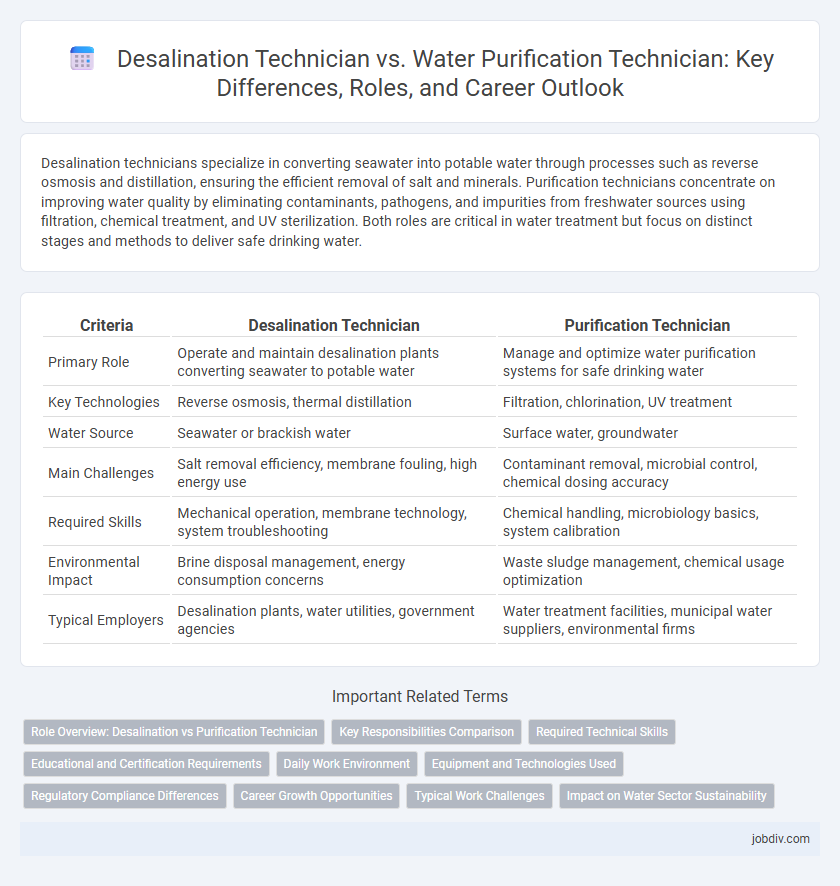Desalination technicians specialize in converting seawater into potable water through processes such as reverse osmosis and distillation, ensuring the efficient removal of salt and minerals. Purification technicians concentrate on improving water quality by eliminating contaminants, pathogens, and impurities from freshwater sources using filtration, chemical treatment, and UV sterilization. Both roles are critical in water treatment but focus on distinct stages and methods to deliver safe drinking water.
Table of Comparison
| Criteria | Desalination Technician | Purification Technician |
|---|---|---|
| Primary Role | Operate and maintain desalination plants converting seawater to potable water | Manage and optimize water purification systems for safe drinking water |
| Key Technologies | Reverse osmosis, thermal distillation | Filtration, chlorination, UV treatment |
| Water Source | Seawater or brackish water | Surface water, groundwater |
| Main Challenges | Salt removal efficiency, membrane fouling, high energy use | Contaminant removal, microbial control, chemical dosing accuracy |
| Required Skills | Mechanical operation, membrane technology, system troubleshooting | Chemical handling, microbiology basics, system calibration |
| Environmental Impact | Brine disposal management, energy consumption concerns | Waste sludge management, chemical usage optimization |
| Typical Employers | Desalination plants, water utilities, government agencies | Water treatment facilities, municipal water suppliers, environmental firms |
Role Overview: Desalination vs Purification Technician
Desalination technicians specialize in operating and maintaining systems that remove salt and minerals from seawater to produce freshwater, utilizing processes such as reverse osmosis and thermal distillation. Purification technicians focus on treating and filtering freshwater sources to eliminate contaminants, pathogens, and pollutants through methods like chemical dosing, filtration, and UV sterilization. Both roles require expertise in water quality monitoring and system maintenance but differ primarily in the type of water processed and the technologies employed.
Key Responsibilities Comparison
Desalination Technicians specialize in operating and maintaining systems that remove salt and minerals from seawater, ensuring efficient reverse osmosis and thermal distillation processes. Purification Technicians focus on treating freshwater by eliminating contaminants, pathogens, and chemical impurities through filtration, chlorination, and advanced oxidation methods. Both roles require monitoring water quality parameters, equipment troubleshooting, and adherence to environmental and safety regulations but differ primarily in their treatment technologies and source water types.
Required Technical Skills
Desalination technicians require expertise in membrane technology, reverse osmosis systems, and brine management to efficiently convert seawater into potable water. Purification technicians must possess skills in chemical dosing, filtration processes, and water quality analysis to ensure contaminant removal and compliance with health standards. Both roles demand strong troubleshooting abilities and proficiency in monitoring water treatment equipment for optimal performance.
Educational and Certification Requirements
Desalination Technicians typically require specialized training in chemical, mechanical, or environmental engineering, often holding an associate degree or technical certification in desalination technology. Purification Technicians generally need education in water treatment processes, including certifications such as the Water Treatment Operator License or EPA-approved courses. Both roles emphasize hands-on training and state-specific licensing to ensure compliance with water quality standards and operational safety.
Daily Work Environment
Desalination technicians work primarily in coastal plants, managing complex systems that convert seawater into potable water, often exposed to high humidity and salt-laden air. Purification technicians operate mainly in inland water treatment facilities, focusing on removing contaminants and ensuring water quality standards in controlled, often indoor environments. Both roles require constant monitoring and maintenance but differ significantly in their operational surroundings and specific technical challenges.
Equipment and Technologies Used
Desalination technicians operate advanced reverse osmosis membranes, thermal distillation units, and ion-exchange systems to convert seawater or brackish water into potable water. Purification technicians primarily work with equipment such as ultrafiltration membranes, activated carbon filters, UV sterilizers, and chemical dosing systems to remove contaminants and pathogens from freshwater sources. Both roles require expertise in maintaining pumps, sensors, and control systems critical for efficient water treatment performance.
Regulatory Compliance Differences
Desalination technicians focus on the removal of salt and minerals from seawater, requiring expertise in regulations such as the Environmental Protection Agency (EPA) standards and the Safe Drinking Water Act (SDWA) to ensure treated water meets potable quality. Purification technicians primarily handle the treatment of freshwater, adhering to local and state water quality regulations including the Clean Water Act (CWA) and specific municipal guidelines for contaminants like chlorine and microbial pathogens. Regulatory compliance for desalination involves strict monitoring of brine disposal and chemical usage, whereas purification emphasizes controlling biological contaminants and maintaining optimal filtration system operation.
Career Growth Opportunities
Desalination Technicians specialize in converting seawater into potable water, a rapidly growing field driven by increasing global freshwater shortages and advancements in membrane technologies. Purification Technicians focus on removing contaminants from freshwater sources, with career growth linked to expanding urban water treatment infrastructure and stricter environmental regulations. Both career paths offer strong growth potential, with desalination often commanding higher salaries due to specialized technical expertise and emerging industry demand.
Typical Work Challenges
Desalination technicians often face challenges related to managing high-energy consumption processes and preventing membrane fouling in reverse osmosis systems. Purification technicians commonly deal with maintaining consistent water quality standards and addressing chemical dosing accuracy to remove contaminants effectively. Both roles require troubleshooting complex equipment and ensuring compliance with environmental regulations to deliver safe, potable water.
Impact on Water Sector Sustainability
Desalination technicians specialize in removing salt and impurities from seawater, enabling access to fresh water in arid regions where freshwater resources are scarce, which significantly supports sustainability in water-stressed areas. Purification technicians focus on treating and improving the quality of existing freshwater sources, reducing waterborne contaminants to ensure safe and potable water that sustains community health and ecosystem balance. Both roles are critical in advancing sustainable water management practices by enhancing resource availability and reducing environmental impact within the water sector.
Desalination Technician vs Purification Technician Infographic

 jobdiv.com
jobdiv.com